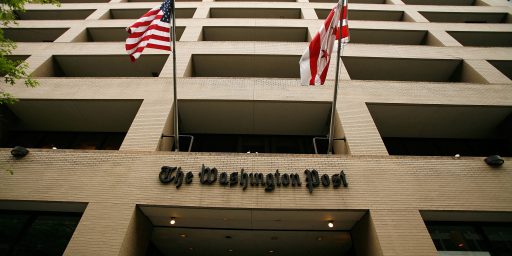The Future of Newspapers
Michael Kinsley has an amusing piece pondering the demise of the dead tree newspaper. After describing in some detail the “Rube Goldberg process” by which we go from live trees to newspapers, he continues:
What happens next is aided by a flat surface, especially on a Sunday near Christmas. The proud owner of up to four or five pounds of paper and ink begins searching for the parts he or she wants. The paper has multiple sections, each of which is either folded into others or wrapped around others according to an ancient formula known only to newspaper publishers and designed to guarantee that no one section can either be found on the first go-through or removed without putting half a dozen other sections into play. Newspaper-industry regulations do not require any particular labeling system for sections, but they do require that if letters are used, the sections cannot be in alphabetical order.
And so, at last, there are two piles of paper: a short one of stuff to read, and a tall one of stuff to throw away. Unfortunately, many people are taking the logic of this process one step further. Instead of buying a paper in order to throw most of it away, they are not buying it in the first place.
Greatly adding to this decision is competition from the Web, including the sites of the self-same newspapers whose sales are declining. The predictable result:
The trouble even an established customer will take to obtain a newspaper continues to shrink, as well. Once, I would drive across town if necessary. Today, I open the front door and if the paper isn’t within about 10 feet I retreat to my computer and read it online. Only six months ago, that figure was 20 feet. Extrapolating, they will have to bring it to me in bed by the end of the year and read it to me out loud by the second quarter of 2007.
I’ve gone through the same evolution. I used to read lousy local papers in some detail every day. Now, my local paper is the Washington Post, by consensus one of the very best in the world. I had it delivered to my driveway for pennies a day but gradually wound up throwing it, still in its plastic wrap, into the recycle bin most days. I tapered off to Sunday-only delivery. I usually go down to get it around noon, several hours after I have perused the online version and perhaps even written up a few blog posts from it. The only reason I keep the subscription is that the supplement (conveniently delivered on Saturdays) contains useful coupons whose value exceeds what I’m paying for the paper.
As Kinsley implies in his wrap-up, there’s no reason this has to kill the industry. Subscription costs cover a tiny portion of the production cost of the paper; the rest comes from advertising. The question is how to make the advertising model work on the Internet.





There are days the newspaper stays at the end of my driveway until my wife and I come back from dinner out.
Unless someone has stolen it, or it’s been washed into the storm drain because the delivery people can’t throw it past the gutter.